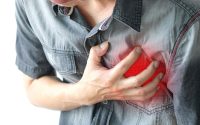Ray Liotta died of ‘silent killer’ that affects half of US adults over 45
Actor Ray Liotta’s cause of death one year ago this month has now been revealed.
Liotta, 67, died from pulmonary edema and acute heart failure in his sleep while working on a movie in the Dominican Republic on May 26 of last year, according to documents obtained by TMZ, due to a condition that affects half of Americans over the age of 45: atherosclerosis.
Dubbed a “silent killer,” atherosclerosis is marked by the slow buildup of plaque in your arteries, complications of which include both pulmonary edema and acute heart failure.
Experts describe plaque as a sticky byproduct in the blood that’s made up of a combination of fat, cholesterol, calcium and other deposits.
As plaque clogs the walls of the vascular system, arteries become hard and narrow.
Eventually, the plaque can block blood flow altogether.
This can lead to complications, such as those that led to Liotta’s death.

What are the symptoms — and deadly complications — of atherosclerosis?
According to the U.S. National Institutes of Health, around half of Americans between the ages of 45 and 84 have atherosclerosis and don’t know it as the disease develops slowly and the onset of symptoms is often delayed until conditions have become dire — and too late, for some.
Most symptoms of the “silent killer” are considered medical emergencies, and if you are experiencing them, it’s important that you seek medical attention immediately.
One of the most common symptoms of atherosclerosis is agonizing and extremely painful muscle cramps in your hips and legs when you walk.
These symptoms will stop when you rest.

It may be an indicator of peripheral artery disease, which reduces blood flow to the legs and arms.
Another common symptom is a “deep, aching pain” in your abdomen area or back, which can mean that you have an abdominal aortic aneurysm.
Chest pain during activities could also be a sign of an incoming heart attack caused by a buildup of plaque in your arteries.
Nonfatal heart attack symptoms vary from pain in the arm and chest to nausea and vomiting, cold sweats and shortness of breath.

Atherosclerosis may also induce a “mini-stroke,” formally known as a transient ischemic attack, which involves a sudden, severe headache, numbness or weakness on one side of your body and difficulty in moving your body or forming thoughts.
This complication of atherosclerosis indicates a patient could be headed for a larger, full-on stroke.
How is atherosclerosis diagnosed?
Aside from the aforementioned physical signals, atherosclerosis may be diagnosed with the help of a blood panel to detect high cholesterol and blood sugar, or a stress test and EKG readings to reveal anomalies in heart rate.
A Doppler ultrasound may also be used: iI takes blood pressure readings in the ankles and arms, showing blips in blood flow throughout the body.
Peering deeper into the vascular system, a coronary calcium scan can see the amount of calcium in the walls of your coronary arteries.

How is atherosclerosis treated?
Atherosclerosis can be treated if caught in time. Lifestyle changes such as quitting smoking, eating healthily and exercising more are often the first steps suggested by doctors.
There are also certain medications that can help to treat the disease, such as blood thinners and statin, which helps lower cholesterol.
In cases of severe buildup, a catheter can also be inserted in a blood vessel, thereby reopening the pathway to the heart.
Who is most at risk of atherosclerosis?
Patients over 45 who are diagnosed with high blood pressure, obesity, diabetes and high cholesterol are considered by medical experts to be at a higher risk for developing atherosclerosis.
Genetics, too, plays an important role and may lead to the disease’s development despite the patient having no obvious risk factors.


